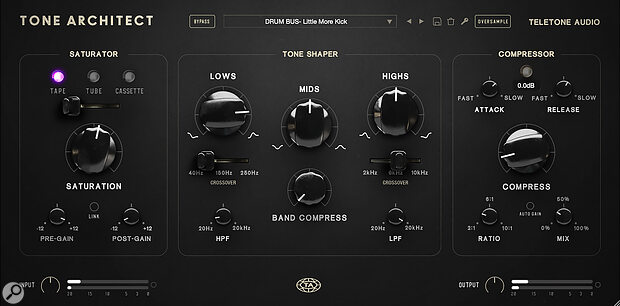Teletone Audio’s Tone Architect might, at first glance, look like just another take on the old channel‑strip idea. But in reality it is quite different, and its main focus is on tonal shaping.
Tone Architect, which supports all the mainstream plug‑in formats for macOS and Windows, offers a sensible balance between flexibility and ease of use, and combines three key processing sections called Saturator, Tone Shaping and Compressor.
The Saturator section itself can be switched between three analogue‑flavoured saturation types too: Tape, Tube, and Cassette. The amount of saturation is controlled by the large Saturation knob, but you also have separate controls for Pre‑ and Post‑gain. Separate Input and Output gain controls at the bottom of the GUI come at the start and end of the overall signal path and include level metering. Oversampling can be turned on to improve fidelity. That comes at the expense of greater CPU overhead, of course, but this plug‑in certainly isn’t greedy when it comes to processing power, and it sounds perfectly fine to me with oversampling turned off. There’s an overall bypass button and you can bypass the individual sections by clicking on the label of each.
The Tone Shaper section comprises a rather unusual three‑band EQ, with adjustable crossover frequencies — as expected the Mid control’s range is constrained by the two crossover controls. The main Lows and Highs controls are not the usual shelving filters but instead have what might be described as a Pultec‑style character — for example, boosting the low end by turning the Lows control anticlockwise simultaneously creates a dip at a higher frequency to keep the sound well‑focused. By contrast, if turned clockwise, a dip is created below the crossover frequency, so these filters also include an element of ‘tilt EQ’. Where this tilt occurs is set by adjusting the crossover frequency, and the curve graphics alongside the controls help show what is happening here. Separate 12dB/octave low‑ and high‑pass filters are each adjustable all the way from 20Hz to 20kHz, and allow you to focus this effect’s contribution to your sound pretty much anywhere you want in the audible spectrum.
There’s also a Band Compress control, which was apparently also inspired by the Pultec: it acts as a three‑band compressor to dynamically pull back where you’ve boosted each band in the Tone Shaper section. Although the Tone Shaper doesn’t behave at all like a conventional cut/boost three‑band EQ, it does make it incredibly easy to dial in sounds by ear, once you’ve figure out what’s actually going on here!
To the right is a transparent‑sounding soft‑knee compressor, with variable Attack and Release times, Ratio and Mix controls, with a large central knob to set the amount of compression. Apparently this was inspired by the API 2500, and if set to its lowest attack time it’s a really fast compressor. There’s no gain‑reduction ‘meter’ as such, but there is a threshold LED that modulates in brightness when compression is taking place, and the amount of gain reduction is displayed numerically. An Auto Gain button is located below the Compress knob. Compressor control values are shown whenever a control is being adjusted, as is also the case for the various gain controls and the Tone Shaper HPF and LPF controls.
This is one audio tool that will get a lot of use once you’ve tried it.
Verdict
Tone Architect is a little different from the norm, but it really doesn’t take long to get used to it, and in most cases it could well be all that’s needed to finesse the tonal qualities of a track: I found I could use it to add depth to drums, give more definition to an acoustic guitar or lend weight to a voice, for example. Tone Architect also works exceptionally well as a bus processor or mix processor, with an ability to act as ‘audio glue’, making all the different parts sound like a more cohesive whole.
Its saturation section works smoothly and sounds to me pretty much like the real thing. On those rare occasions that you do need more control over the EQ balance, adding another plug‑in with high‑ and low‑shelving EQ controls will take care of it, but in the majority of applications, Tone Architect will do all that’s needed without such assistance. I think that this is one audio tool that will get a lot of use once you’ve tried it.

